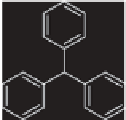Environmental Engineering Reference
In-Depth Information
Table 6.1
Examples of common chromophores in synthetic textile dyes [1].
Chemical Class
Base Structure
Examples
Anthraquionone
Reactive Blue 19 (Remazol
Brilliant Blue R), Acid
Blue 225, Poly R-478
Azo
Acid Orange 7 (Orange II), Acid
Orange 10 (Orange G), Acid
Red 2
Heterocyclic
(Phenothiazine)
Basic Blue 9 (methylene blue),
azure B
Indigoid
Acid Blue 74 (Indigo Carmine)
Phthalocyanine
Pigment Blue 15:2
(Phthalocyanine Blue BN),
Reactive Blue 15
Triarylmethane
Basic Violet 3 (Crystal Violet),
Basic Red 9, bromophenol blue
6.2.3 Environmental Impacts
Owing to their complex chemical structures, synthetic dyes are often recal-
citrant and very difficult to be decomposed or removed by conventional
wastewater treatment processes, as well as in the aquatic environment [1].
In fact, these synthetic dyes are created as improved alternatives to natural
dyes with longer lasting color and wider applicability to a variety of con-
sumer products. Therefore, these compounds are chemically very stable by












































Search WWH ::

Custom Search